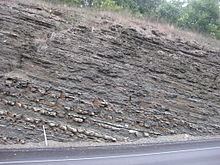Type sedimentary Named by Charles Butts, 1918 Overlies Harrell Formation | Primary Slate, Sandstone | |
 | ||
Sub-units Black Creek Siltstone Member, Minnehaha Springs Member Thickness 1350 to 1800 feet in central PA | ||
The Devonian Brallier Formation is a mapped bedrock unit in Pennsylvania, Maryland, West Virginia, and Virginia.
Contents
Description
The Brallier Formation was described by Charles Butts in 1918 as a fine-grained, siliceous shale with few fine-grained sandstone layers, from outcrops in central Pennsylvania. Others expanded usage of the term to rocks in other states.
Stratigraphy
The Brallier is roughly equivalent to the Scherr Formation.
The contact with the underlying Harrell Formation is generally gradational.
Fossils
Hasson and Dennison reported the following fossils from outcrops of the lower Brallier at Keyser, West Virginia, Ridgeville, West Virginia, and McCoole, Maryland:
Notable Exposures
Type locality is at a railway station 6 miles northeast of Everett, Bedford County, Pennsylvania.
Age
Relative age dating places the Brallier in the late Devonian.
